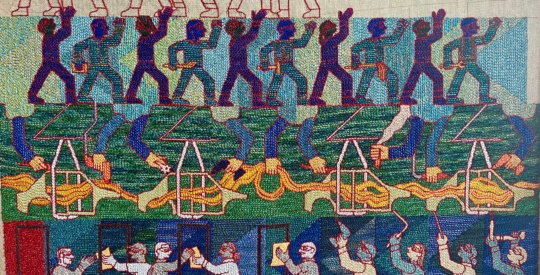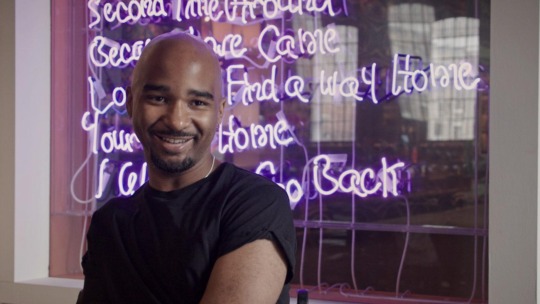
As a newcomer to the Atlanta art world, I’ve learned a lot about the Southern scene over the past year. And last month, I experienced a condensed version of the whole affair over the course of a single weekend at Savannah’s 21st Annual Telfair Art Fair.
Described in publicity as a “beloved outdoor event in the heart of historic Savannah,” this year’s festival took place November 13 – 15 and featured 85 artists with displays set up around Telfair Square (including my husband). There were a few other noteworthy components:
+ A ticketed “Arty Party” kicked off the festival on Friday, described on the website as a “highly anticipated event” that “gives guests an exclusive opportunity to preview and purchase the featured art and meet the artists at a chic cocktail reception.” Ticket prices ranged from $85 to $175.
+ A chance to see “Monet and American Impressionism” at the adjacent Jepson Center, part of the Telfair Museums (on view October 16 – January 24).
+ Lots and lots of SCAD students.
Dear reader, some of the most important things I now know about art in the South are in those descriptions. “Beloved” and “historic,” like once-distressing-and-disruptive Monet. The focus of a great cocktail party for those who can afford it, with emerging artists lurking around the edges.
“But wait!” you say. “That’s totally inaccurate! There’s much more to art in the South! What about all the exhibitions chronicled in this very magazine, and the Goat Farm, and the Mint, and … ”
I’m going to interrupt you now, because you’re right, of course. But today we’re visiting a different place in the art world. It’s is a very pretty, well-appointed place, and the people who live there pay more for their haircuts than some people earn in a week.
But first, let me tell you how we got to Telfair. The party wasn’t what initially lured us in. We were enticed by the promise of $11,000 in prize money (including the $5,000 Carolyn Luck McElveen Best of Show Award) and the hope of expanding our reach beyond Atlanta. We were thrilled at the chance to get work in front of people who can afford $400 shoes, weekly massages, golf games, and a $175 ticket.
Events like this are the engines fueling the production of artists without trust funds or regular salaries. They offer the possibility of meeting your Frederick Leyland, the shipping magnate who supported Whistler, or your Daniel-Henry Kahnweiler, the gallery owner of whom Picasso reportedly said, “What would have become of us if Kahnweiler hadn’t had a business sense?”
Savannah might not have as many Leylands as, say, New York, but Telfair’s Arty Party still inches toward the upper end of the scale – not Art Basel Miami Beach, but respectable. It showed in the Friday crowd, most wearing “Disposable Income” like an Armani suit. Women in lush scarves and tasteful makeup. Men in jackets that fit and shirts that were professionally laundered and pressed. Bodies that said, “I have a personal trainer and time to play tennis.” No unpedicured toes. No unmanicured nails. All of it whispered, “Yes, I’ll take the $2,000 painting for our beach house, and I’ll pick up that little $300 necklace too.”
We loved our short visit to the place where these people live. I’ve visited many times before, having worked 12 years in fundraising, so they weren’t total strangers. It was nice to go back to the catered food, the free drinks (yes, drinks, as in liquor), and people who talked gaily about their last trip to Italy. They bought things. Everyone was happy.

The next day, they were gone. The regular art festival crowd returned. In our admittedly limited experience, a substantial portion of these visitors are a) locals out walking the dog; b) parents desperate for something to get the kids out of the house; or c) students desperate to find something they can do for free. We enjoy spending time with them. We even smile and agree when they say things like, “That looks like a cat you’ve painted in the corner there!” But we knew that the greatest chance for big sales had drifted away with the last whiff of Chanel No. 5.
And we didn’t win a prize.
That night we had dinner with a couple of local artists, friends from another era. One talked about her combination fax machine/lawn mower/paper shredder – a surprisingly beautiful piece. I asked her if she’d ever exhibited at the festival in her many years living in Savannah.
“Once,” she said. “It didn’t go very well. And with my teaching job, it’s hard to keep up with my own art.”

Her husband agreed. He holds an MFA and works at the museum. When he has time, he creates gorgeous and thought-provoking works out of discarded plastic items picked up along the beach. But that time is very limited. You get the feeling that the academy and the museum are their Kahnweilers – demanding, unyielding Kahnweilers, who call them to pour out their creative energy for others to guzzle down like PBR.
But I don’t think any of that mattered. We were with other artists. Someone is paying us to do what we love, and so far it’s been enough. And those SCAD students – I love them, with their Doc Martens (makin’ a comeback, y’all!) and anime T-shirts and man buns. I hope they will be making crazy art when they’re my age. I hope they find their Leylands.
Jami Moss Wise is a lapsed academic with a Ph.D. in English from the University of Wisconsin-Madison. She went into business full-time with her artist husband this year.
Art Festivals: A View From the Sidewalk
Related Stories
Features
Art21 x Burnaway
Reviews
Weaving Work: On the Tapestries of Tabitha Arnold
Lina Alam profiles the spiritual allegories and the labor of weaving works created by Chattanooga-based artist Tabitha Arnold.
The Incredulity of Jacolby Satterwhite
In April's Art21 x Burnaway feature, we enter and explore the resurrection, rebirth, and regenerative quality of Jacolby Satterwhite's virtual worlds.
Orchid Daze by Lillian Blades at the Atlanta Botanical Gardens
Blake Belcher reviews Atlanta-based Bahamian artist Lillian Blades' new work engaging orchids, transplantation, and diaspora at the Atlanta Botanical Garden.




